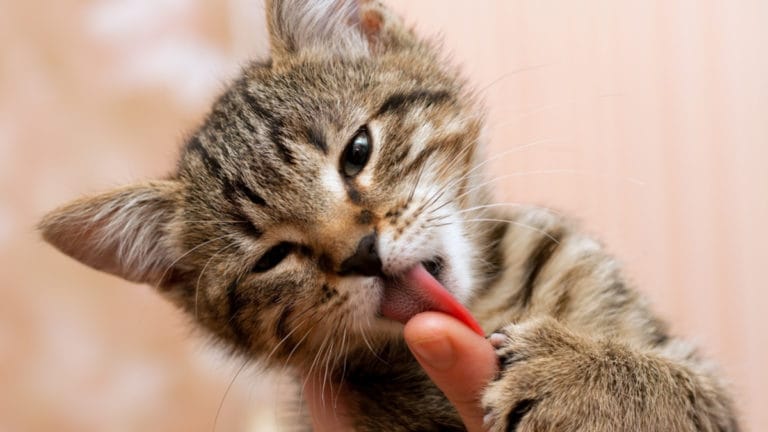Cats can often get a bad rap for being unresponsive and/or aloof, but the key to communicating with your cat can be as simple as paying attention to its behavior. By knowing your cat well enough to detect even subtle differences in its behavior and body language, you can master the art of feline communication.
Marilyn Krieger, a certified cat behavior consultant and author, says a little common sense goes a long way when to talking to your kitty.
“The first step is to be aware of your cat’s body language,” she says. “Stop and think about what the cat is doing, why it’s behaving the way it is, and realize it could be a medical problem. Cat owners need to be aware of the first sign of any changes in their cat’s behavior and take them to the vet to have them checked out. If they’re doing things like hiding or their behavior isn’t the same sweet behavior—these are all signs. It could be a painful or serious situation.”
One of the biggest mistakes cat owners can make is to assume that cats think and behave like we do. Krieger says she often encounters clients who think their cat misbehaves to get back at them for something they’ve done, like leaving them to go on vacation.
“Cats don’t do things for revenge. That’s something people do,” she explains. “If a cat is feeling insecure it may urinate on the bed but it’s not a revenge thing. It may be feeling fearful. Their motivations are different from what a person does.”
Pam Johnson-Bennett, a fellow cat behavior expert and author, agrees. “Cats use vocabulary, touch, scent and body language to communicate with us. We’re more verbal. So we might not recognize their signs,” she says.”
Here are some general guidelines to help you decipher what your cat might be trying to tell you.
A Vacation From Abandonment
Cats can be deeply affected by your absence, and leaving out extra bowls of food and water for your weekend getaway isn’t the simple solution to making them happy. Your cat may show it’s upset by acting out, being needy, sitting in your suitcase or even peeing in it.
If this happens Johnson-Bennett says it’s best not to make a fuss over your cat or try to cuddle it and or be very vocal with it. “These kinds of actions set off alarms. Your cat knows if you’re acting overly dramatic. This may lead her to think the bottom must be about to fall out of her world,” she explains.
Krieger says you can communicate to your cat that you’ll be leaving by preparing her ahead of time. She suggests bringing your suitcase out prior to your trip and leaving it out so it can get used to it. Initiate some play around it. Choose someone your cat likes to either stay with them or visit them twice a day. If it’s possible try to have the pet sitter stick to your cat’s regular schedule.
For cats who have separation anxiety, Krieger suggests taking items such as an article of clothing or a towel for each day that you’re going to be gone, putting them close to your skin and then putting them in a sealed plastic bag. Ask your sitter to put out one item for each day that you’re gone. Krieger says even phoning home can help, telling Pet360, “I’ve had clients Skype with their cats. Or, if you have a landline, you can call and leave a message for your cat on your answering machine.”
How Cats Grieve
Cats, like humans, can grieve the loss of a companion. Johnson-Bennett explains, “If you experience a loss in your household you should just assume your cat is going through the grieving process even if your cat didn’t like the animal or person who passed away. Your cat will grieve because she’s confused.”
Cats may tell you they’re grieving by howling, pacing or even refraining from eating. They may want to hang out in the room where their companion spent time. They may show you that they need your support by clinging to you or requesting extra attention.
Cats are also perceptive enough to pick up on their owner’s grief. If that happens Krieger suggests grieving in private somewhere away from your cat.
It’s also important not get another cat when your cat is still grieving. There’s a process involved to acclimating a new cat into a new environment that can complicate things. “Grief is stressful and getting a new cat is stressful. There’s a hierarchy that goes on with a new cat. Each cat may need to have its own room,” she notes.
Other suggestions to help your kitty cope with her grief include keeping things that have the old cat’s scent on them around the house, playing with your kitty, and/or treating her to a new toy or giving her a deep brushing or combing.
Keep Calm and Vacuum On
If your kitty runs under the bed when you turn on the vacuum it may help to repeatedly expose her to the sound in a safe and controlled manner. Krieger recommends making recordings of events or noises that frighten your cat and then playing them back in short snippets at a low volume. After 2-3 times on low, gradually increase the volume and length of each recording. Give your cat a treat each time you play the recording. Then make the noise in another room and have a friend sit with the cat in a different room and monitor her behavior. The idea is that eventually the cat will become desensitized to the sound or event.
For crisis situations that you can’t prepare for—like a thunderstorm—Johnson-Bennett recommends providing a hideaway place your cat can go and find security such as a cardboard box on its side.
“Don’t try to hold your cat or comfort it because it will feel confined,” she urges. “When a cat is scared the best thing for a cat is to retreat and hide. We want physical comfort. But cats want to escape. When you try to comfort your cat you’re sending a mixed message. If your cat is hissing because she’s scared and you comfort her, the message is ‘yes, you’re absolutely right for being terrified. Be careful of the message you’re sending.”
Taking A Bite Out of Aggressive Behavior
Sometimes a good head scratch can go horribly wrong when your cat turns on you and bites you. Krieger likens this aggression to a human foot rub or a back rub that all of sudden doesn’t feel good. Your cat will usually warn you that it has had enough, but many people don’t know how to recognize the signals. “Their tails may be moving rapidly back and forth, their ears and whiskers may be flattened, or their skin rippling. This means ‘Lay off, I don’t want this’,” Krieger explains.
Cats may also express aggression by shifting their body position, and they may stop purring or turn around to look at you. If it can’t get its owner to stop with any of these signals, it will often resort to aggression.
“Your cat is basically saying ‘I’ve run out of warnings the only thing I can do is to bite you,’’ Krieger adds.
“Cats are masters of communication, but they’re just not as vocal. We’re not good at reading body language. We tend to ignore the warning signs that an animal has had enough. Then the cat gets in trouble for being aggressive even though he was giving signals. We just didn’t pay attention to him,” Johnson-Bennett says.
At this point she advises that you communicate that you understand your cat’s wishes by carefully standing up, leaving and then ignoring your cat. Yelling or swatting at them will only make your cat more defensive. She says if you try to make up with your cat it will interpret that as a reward.
“The best thing is to ignore him so he sees that biting stops any kind of interaction with you. And then it’s your job to figure out what you can do to change the outcome next time,” she says. “If, for instance, you know your cat likes to be petted for three minutes and then it bites you, pet him for half that time. Leave him wanting more so petting becomes something positive.”
Making Your Mark
Krieger says you should never corner a cat, even if you want to show them affection and attention. “It should always be the cat’s choice,” she says. “If you want to try and make contact and give them affection you can squat down and point your index finger. If the cat is interested it will come over and rub its chin and mouth to the side of its cheek where its sensory glands are. Once the cat ‘marks you’ you can then try petting them on the head.”
Cat Litter Box Blues
If your cat is going other places instead of using its litter box it may be trying to tell you that there is a health issue or that she doesn’t like how things have been set up. It’s important to first take your kitty in for check up so your vet can rule out any health issues.
If it is a behavioral issue then Johnson-Bennett recommends looking at things from your cat’s perspective.
“Ask yourself if it’s cat-appealing. Is it the box too small? Is it dirty? Are there too few boxes per household?” Did we set it up because that’s how we want it to be?” she says.
Krieger adds that cats don’t like being in a place where they can be potentially cornered or where they feel trapped. So it’s best to put the box in an open area where your cat can easily exit if it feels threatened. Your kitty may also feel trapped in an enclosed or covered box. It’s best to provide a large, uncovered box that doesn’t retain odors and allows for easy access.
Felines and Furniture
If your kitty is clawing your couch instead of its scratching post, it’s not doing it to be naughty. It’s probably telling you that it prefers to scratch in a different location or on different fabric. Cats prefer using a tall, sizeable post made out of sturdy material.
Johnson-Bennett says to avoid soft, carpeted material and to pay attention to where your cat is currently scratching and put the post there. You may even need two or three posts.
If you’re introducing a new scratching post she recommends showing your cat you want it to use the post by putting it in the center of a room. Then get a fishing pole type toy and play with it on and around the post. Eventually he’ll put his nails into the post and realize it’s a good thing. Then give him a treat.
Krieger says punishing a cat for clawing the furniture won’t work because scratching is a natural behavior that cats do to relieve stress, mark their territory and play and maintain their nails. She says cats can be trained in three steps to scratch the right objects.
- Block scratched areas with double-sided tape, sheets and other unappealing textures.
- Place scratching posts in front of blocked areas.
- Reinforce your cat whenever he scratches the right objects.
Time and Punishment
If your cat is doing something you don’t want it to do that doesn’t make it a bad cat. It’s important to remember that your cat is acting a certain way for a reason. Try to understand its point of view. For instance, a cat that jumps up on the counter top may be expressing its need to network with people at a higher point. Cats need vertical territory. So try keeping the counter top clean and provide a cat tree or perch near the counter.
Johnson-Bennett advises her clients not to respond to their cat’s behavior by giving it attention.
“If your cat jumps on the counter don’t look her in the eye, just pick her up off the counter and then put her down. Then ignore her,” she explains. “One of the mistakes I see my clients do is to look their cats in the eye and talk to them and even hug and kiss them as they remove them from the counter. If you don’t like your cat’s behavior figure out what the pay off is and what else you can give her.”
Krieger is against hitting and thinks yelling should only take place in an emergency, like if the cat is immediate danger if it’s about to jump up on a hot stove. “There are times when it’s appropriate when it’s going to save the cat’s life. It may be appropriate to yell or scream. When you punish a cat it associates the behavior with the person. Punishing can break the bond between you and your cat,” she says.
Clicker training can be a much more effective way to communicate with your cat when it comes to discipline. This technique involves using a device that makes a short, distinct “click” sound as a way to signal to your cat that you like what she is doing. (If your kitty is hard of hearing try using a flashlight. You can also follow up with some additional positive reinforcement such as a treat or a friendly belly rub.)
“The cat has an association with the sound of the clicker. It’s classic conditioning communication,” Krieger explains. “If you want to encourage your cat to use its scratching post, click as your cat is scratching and then give it a treat to reinforce the behavior you want. It’s great way to build communication and increase bonds.”
Krieger also advises owners to remember that their own behavior plays a role in good communication. “If, for example, your cat cries and you always pick it up, then it thinks, ‘All I have to do is cry to get my favorite person to give me attention’,” she says. “People don’t realize that they may be reinforcing their pet’s behavior. Your cat will repeat whatever behavior you reinforce or allow.”

Infographic: Josh Carter

Katherine Tolford writes features that connect readers to insightful stories and topics about animals, people and culture.
Share:









